Which colour of mulch should you use in your landscaping? This was a hot topic on my Instagram stories this week, so I decided to write about it here. Because, just like any other colours on your exterior, the colour of mulch needs to be carefully considered.
But first… we have a WINNER! Congrats to Sarah Bell – you are the lucky survey respondent who receives a free Exterior Colour Selection masterclass. And, thank you to all of YOU for sharing your input with me! I love hearing from so many of you!
It’s exterior season, time to think about a fresh paint job or starting that exciting landscaping project. And even though mulch is not something I install until after the Fall clean-up, I see so much distracting red mulch that I think we need to talk about it here.
Why is red mulch so popular?
Because I have never ever seen red mulch that looks good.
My sister inherited red lava rock on her garden beds and it looks no better.
I use black mulch for my garden beds (below) but now I’ve learned that it’s poisonous to pets. Thankfully, we don’t have any at the moment.
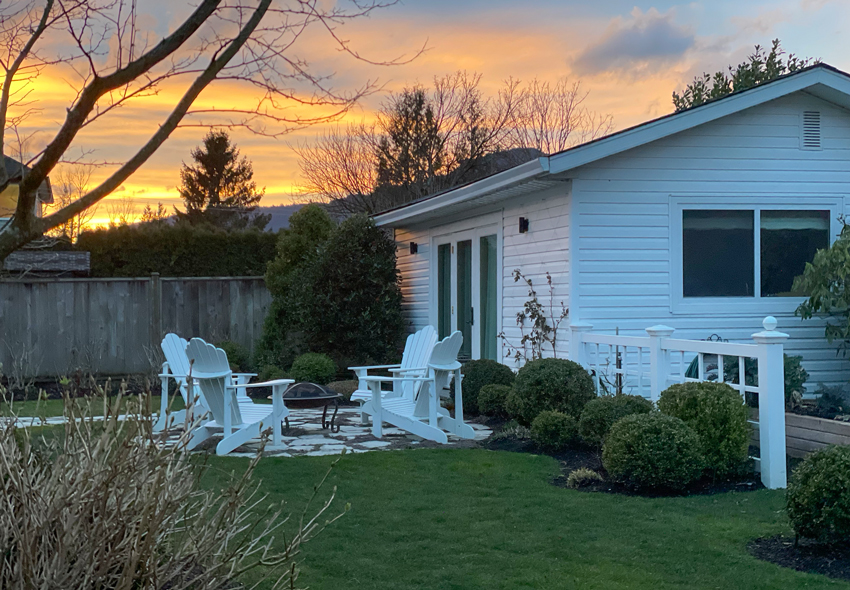
Maria’s Design Studio
Maria’s Backyard Garden
Earlier this week I asked my Instagram followers why red mulch even exists? I received countless comments with STRONG opinions, haha! Some said it even stains the concrete around it and kids’ clothes if they play near it.
Here were a few more comments:
“Ants do not like red cedar and the darker brown/red hemlock mulch. They are sometimes attracted to the sweet pine in brown and black mulch”
“They work in Arizona and southern Utah to go with the colours of everything but not sure why they sell it anywhere else”
When I read this comment (above) I looked up Arizona red mulch and I found this image (below) with natural brown mulch. I think it’s way better to have red/orange in the plants to match the Mediterranean roof rather than matching the colour with mulch.
‘Red mulch is made from things like recycled wooden pallets, not bark. Dyed red to make it a uniform colour. Why red? Supposedly they used cheap iron oxide blend the various colours of wood chips. It turned red. Someone thought it a feature rather than a problem.’
‘I hate red mulch. It is offensive to Mother Nature. I am in Florida and my neighbours use it because it is cheap and is often on sale at the home improvement centres. But that doesn’t make it any easier on the eyes’
I loved this comment I found online because I think this says it best:
The trouble I have with colored mulch is that it hurts my eyes when I look at it. I find myself exclaiming, “Look at that red mulch,” instead of, ” Look at that gorgeous landscaping.”
How to Add Colour to Your Landscaping
I think the biggest possible reason why red mulch is chosen is that it adds colour to your front yard when what your house really needs is landscaping. More plants.
This gardener (below) was clearly craving more colour and impact after adding way too few plants to the bed.
While we’re here, talking about red mulch, can I just mention the red/burgundy tree that everyone feels compelled to buy for their front yard as well because it’s “different” from green?
It’s like accent tile for the garden. Distracting and unnecessary.
Read More: Should you install the current, trendy accent tile?
I am here to tell you that I am no different. Years ago when I was in my late 20’s helping my uncle choose plants for the home he had just purchased, we picked out a red maple.
When we first moved into this house, it came with a big burgundy maple tree in the backyard. And later that Fall when we were raking the neverending piles of leaves, I asked MaryAnne if we should get rid of it. “Off with her head” was her reply! Ha, ha!
If you go for a drive, you will have a hard time finding a yard that DOES NOT have a red tree in the front yard.
All I have to do is look across my street and I see three of them (below):
Now of course this advice is only useful if you are planning a new garden. So, if you already have a burgundy or red tree in your front yard, the way to make it work is by adding pink and purple flowers.
To be clear. There’s NOTHING WRONG with it if it RELATES to the plant material in your garden but just to plunk it in for interest, is like choosing obligatory accent tile just BECAUSE.
But back to the problem of red mulch. The point of good landscaping is the structure and interest of the PLANTS, not the MULCH.
Red mulch screams for attention in a way that is simply not its place.
The goal of a good garden should be to have enough ground cover with your plants that the mulch isn’t a design element at all. If you do see some mulch, it should be brown or naturally weathered to grey and fall away as a backdrop.
So, my advice is to add colour to your landscaping with plants – flowers and shrubs – rather than red mulch or burgundy/red trees.
Read More: 500 White Tulips Blooming in my Yard
Which colour of mulch is best for your house?
Let’s remember, the purpose of mulch is moisture retention in the soil and weed suppression. It is NOT a design feature.
Since it always plays a supporting and functional role, you can just go ahead and pick the plain old natural wood mulch. It’s arguably healthier anyway.
Read More: My New Boxwood Garden Beds: Before and After
I hope this helps your show off your beautiful plants as we head into gardening season this year!
I’d love to hear about your adventures and misadventures with choosing mulch. Have you ever been seduced by bright orange-red mulch hoping to bring some colour to your yard?
Related posts:
Danger: Your Designer as Left the Building

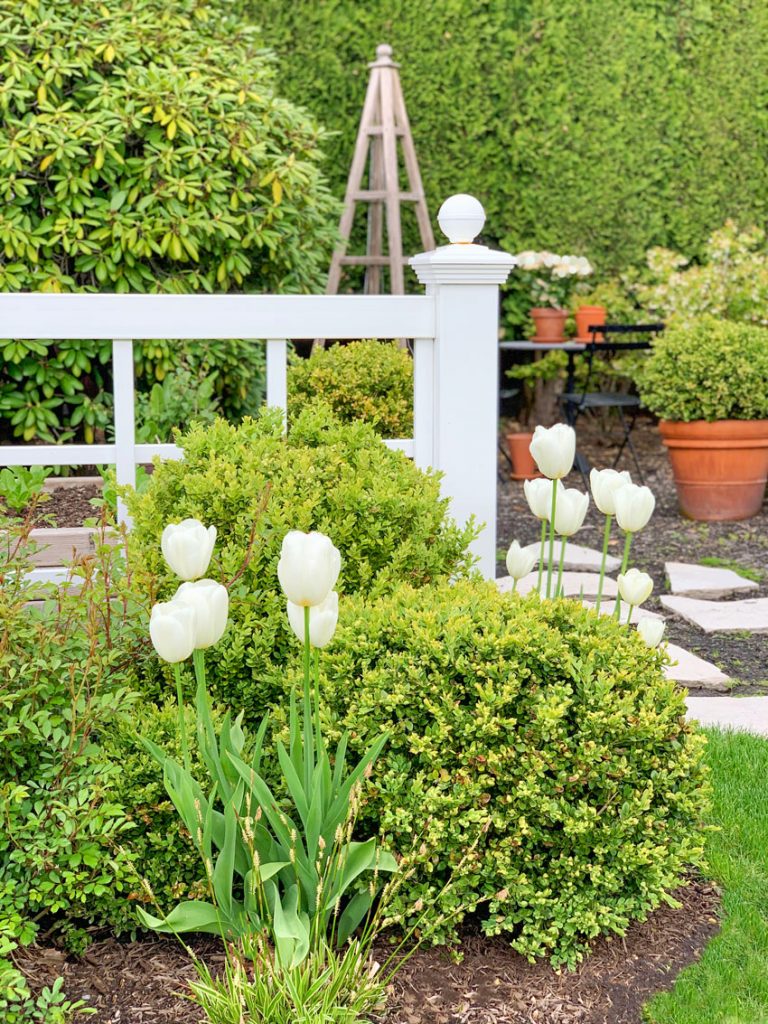

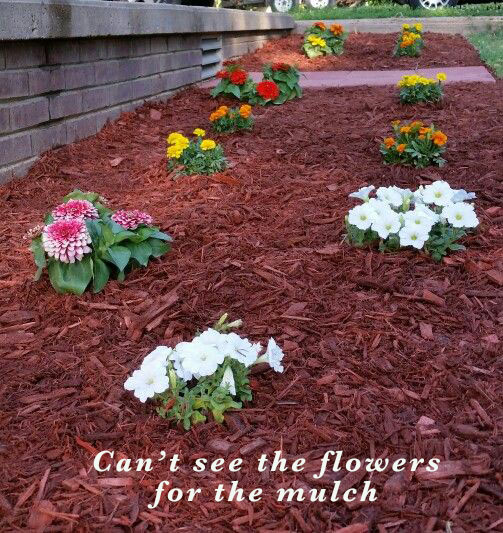
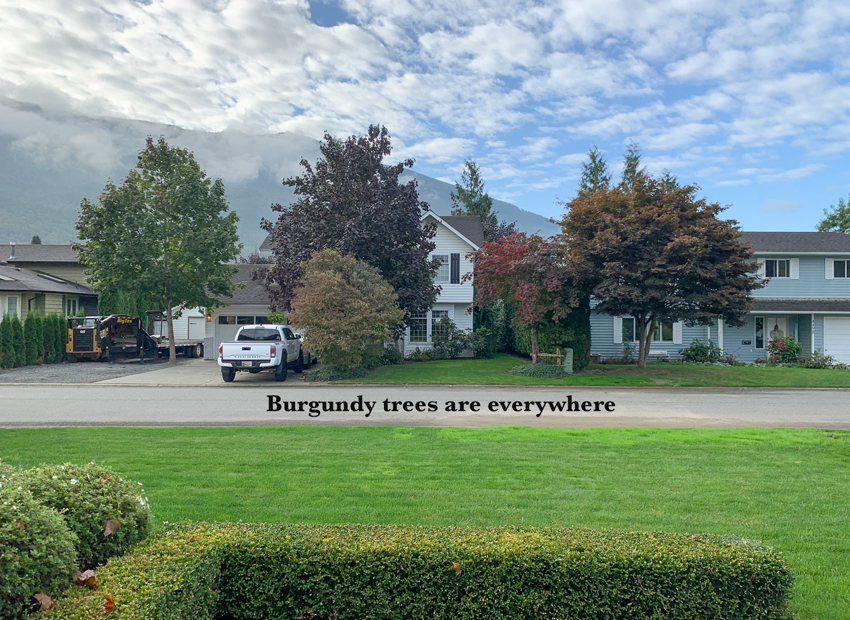
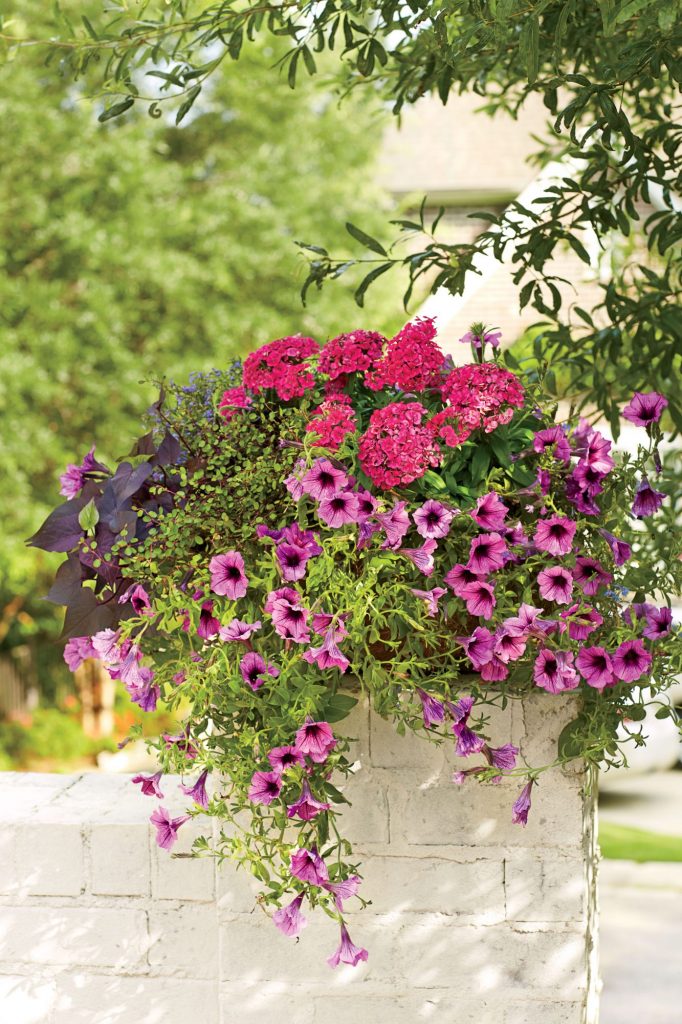
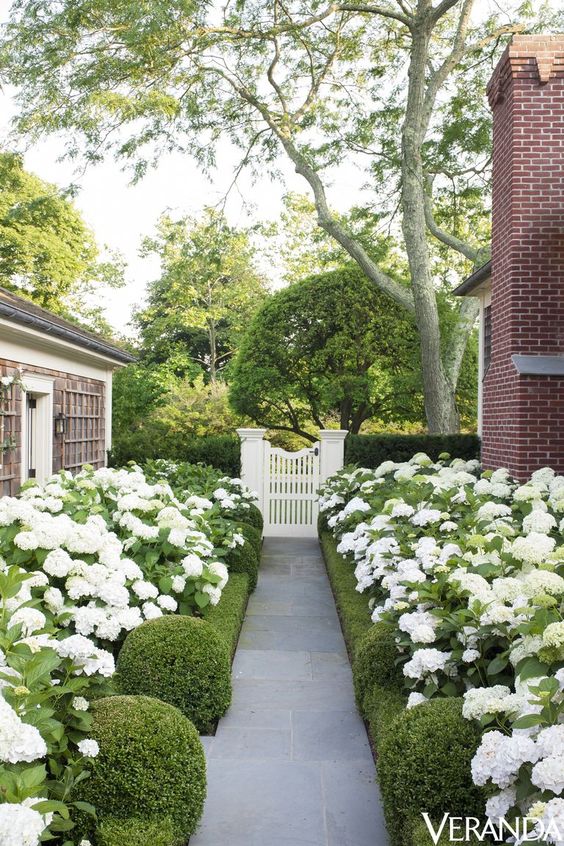
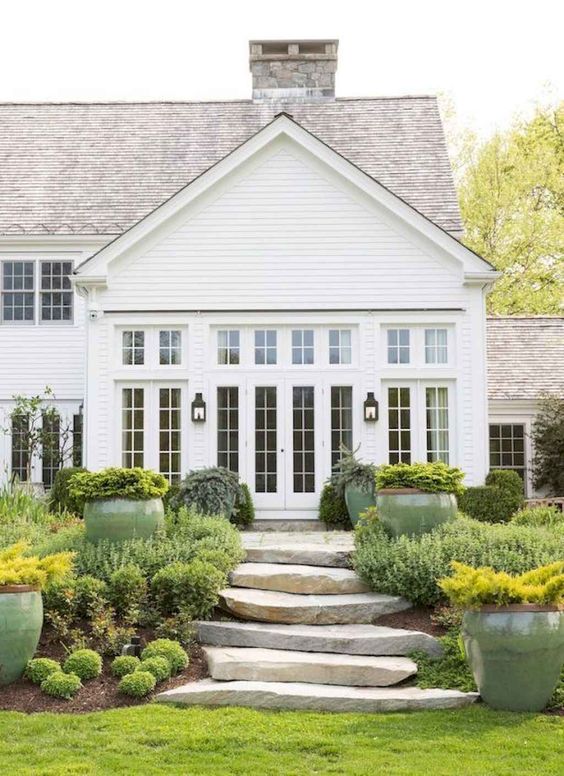
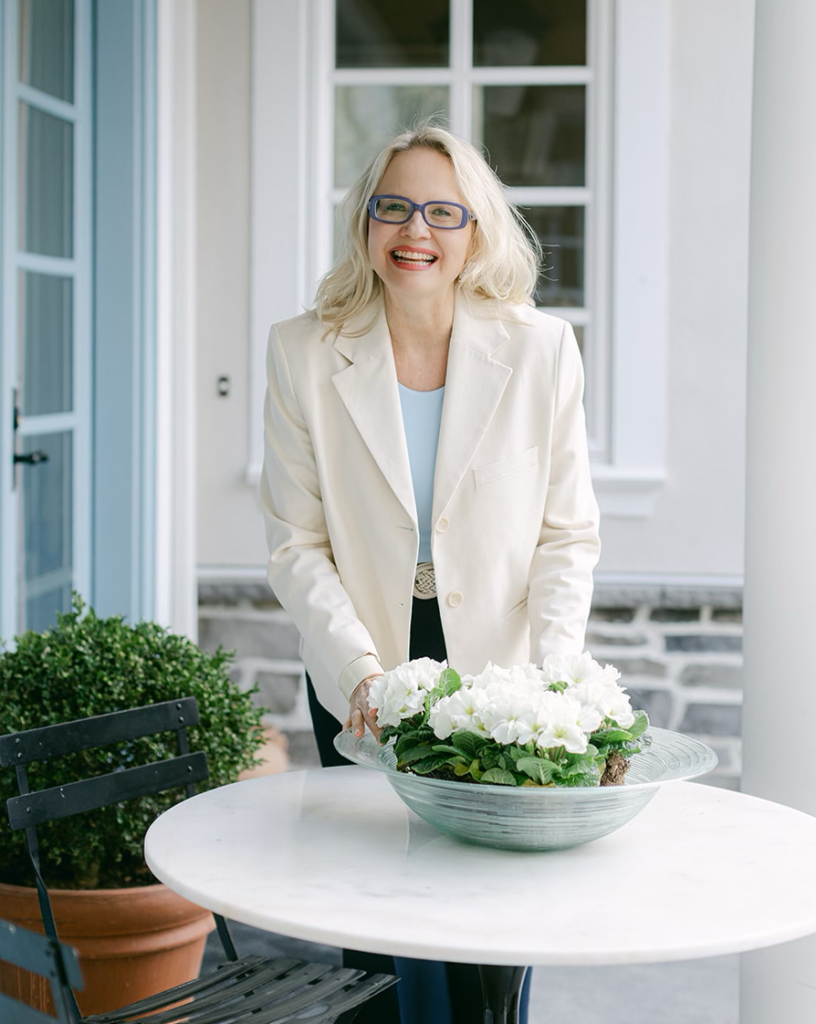



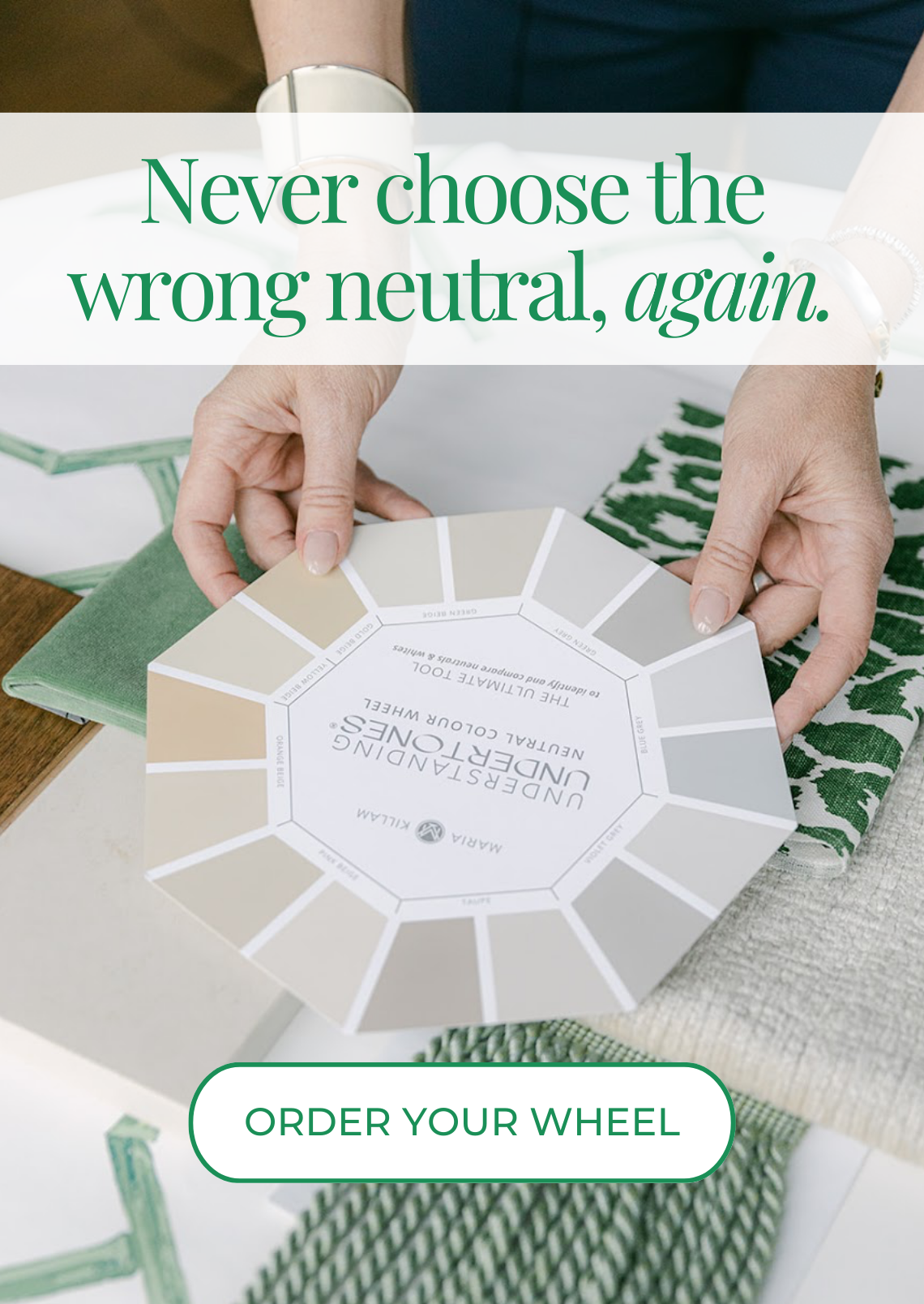

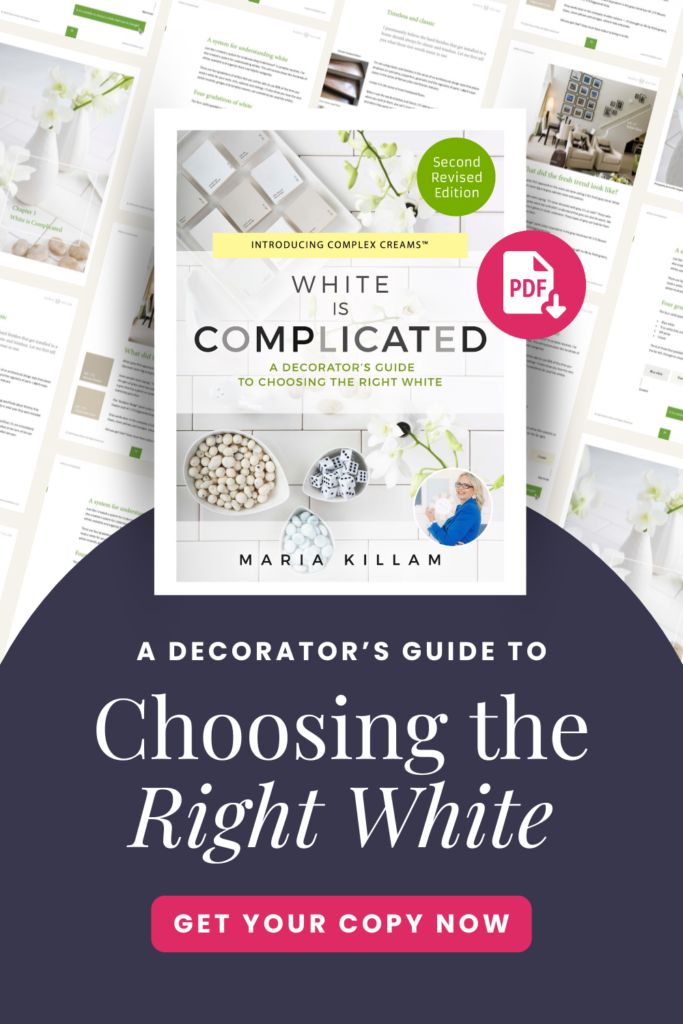
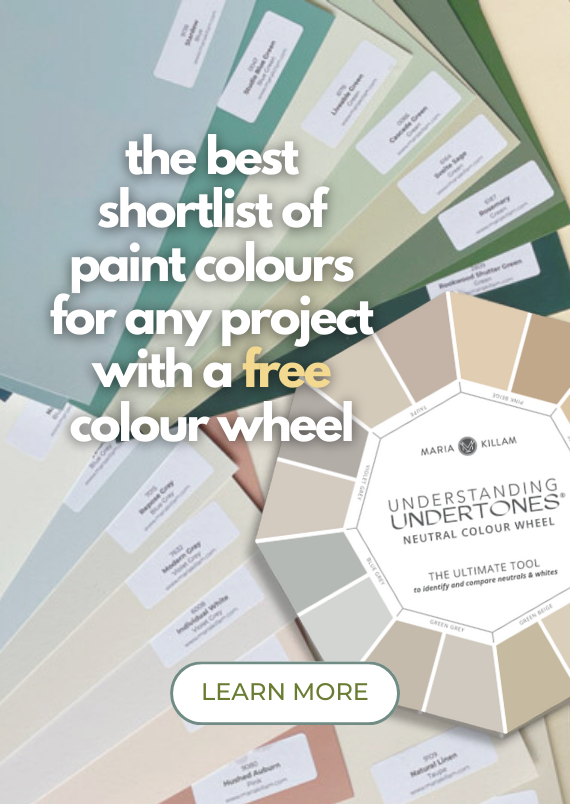


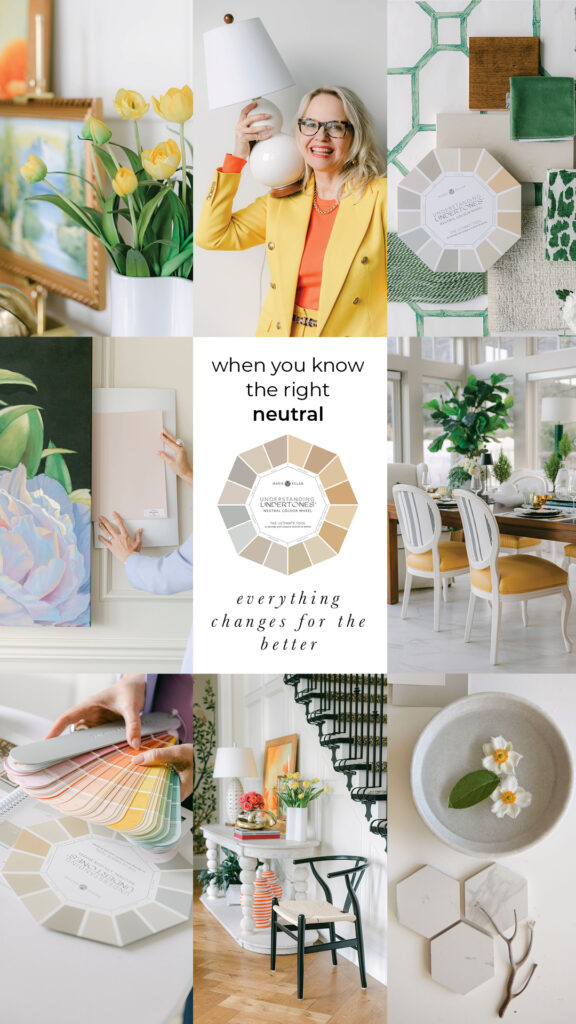

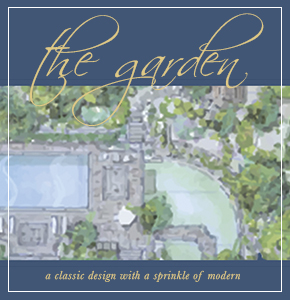



Red mulch reminds me of fast food restaurants and gas stations – that’s what many have around here.* It’s teeth gritting. The colors in flowers and trees provide color. And painted benches or chairs. #noredmulch
*And please don’t put mulch against tree trunks! It can eventually kill them – not today, not in a few years maybe, but they need to breathe.
Exactly! Hello, Taco Bell!
It’s so so ugly..it makes me see, well..red!
Mulch has a purpose but it’s not its job to yell, “Look at me.” That’s the job of your plants and landscaping. If you put in a lot of plant material they should grow so that most of the mulch is not visible anyway.
Red mulch reminds me of Gains Burger dog food. I never mulch. Adding compost, is much better for the soil to maintain fertility and soil structure (and free if you make it yourself). Don’t get me started on mulch tree volcanoes. Great for rotting.
Black mulch is my only choice!
Red mulch is dyed (not natural) so for that reason it’s a no, and it doesn’t look good anyway! Where I live, Northeast, the black mulch is dyed as well. I used that one year, then onto pine but that faded. Best so far for me is natural hemlock. Looks good all season! I do love the buckwheat hull mulch and used that one year but it blows all over!
OMG I CANNOT STAND red mulch or lava stones. You are right, I never look at the home or landscaping, but Just at the darn red!
I use the black mulch that is not dyed, but rather burned, to give it the black look.
And you totally got me there, we thought a red maple would kick things up in our old yard, haha!
No I’ll think of you every time I will drive past a red maple!
Love this post. I am very strongly against red mulch…and thank goodness someone else is not a fan of red trees. I do like the maples that turn in the fall…just not all year!
We had red mulch for one season. It was an impulse buy at the garden center. It clashed with our red-orange brick (mulch was more blue-red and a stronger color). Replaced with darker neutral brown mulch or black mulch after that. (We change it out when needed and husband brings it home and takes care of it… but no more red.)
This is interesting. I hate all mulch except those that feed the soil. I love to garden and while I think expertly planned gardens are gorgeous, if I had to worry about the colors of my plants matching I would probably have an anxiety attack and hate gardening. So I just keep doing what I love instead and that’s okay, too! I so enjoy all your advice!
Thank you, I was just coming here to say the same thing. I use gorilla hair on top of the compost it I feel the need for more cover.
More importantly, nobody should be using wood mulch with flowering plants (as in the picture with the red mulch.) As wood chips break down the process they go through uses up nitrogen from the soil. Lack of nitrogen causes weak growth and pale, yellowed foliage. Already decomposed mulch is okay. Compost would be a far better choice.
Very good point! Shredded leaves from the yard can be casually composted and tossed onto perennials in the early spring. And perennials should be thickly planted. If there is still a weed problem in the perennial bed, what’s needed is more plants, not more mulch!
I used red mulch ONCE 30 years ago and immediately wanted to put a for sale sign on the lawn and a bag over my head every time I stepped out the front door. Thankfully it faded a bit in the sun over that summer but was still ghastly until I was able to replace it with plain old brown. At that point I hadn’t learned your “Boring Equals Timeless” mantra but it was a lesson in not being drawn to “interesting” when the focus should be elsewhere ie the plants and landscaping.
NO to red mulch. it’s the one thing i do not have to think twice about. just, NO.
The battle of the mulch! My husband adores red mulch, I like dark brown. When we bought our house, we finally agreed that he could use the red mulch around the house where all the green hedges were (which are large enough so it’s all in shadow) but I was using brown mulch in all the flower beds, no matter what. This ‘agreement’ occurred because he went ahead and put in the red mulch when I was away visiting a friend. I may have been a tad irritated upon my return. It still festers.
We now have to revisit this, because we removed some hedges and, for real, the red mulch near the front door is too much! It’s just shocking!
Should I send him on a trip to visit his friends?
🙂
Thank you Maria! Your post is truly a Public Service Announcement. Stores need to stop selling red mulch and people need to stop buying it …period.
I’m surprised no one mentioned the obvious — red mulch is just cheap brown, sometimes synthetic, mulch dyed to look like cedar. Cedar repels insects. Dyed red mulch does nothing but hurt the environment, the eyes, and the aesthetic. It’s like putting a tacky plastic tree or fake flowers in your garden.
Yeah, this. Also, dyed mulch (of any color) is bad for the environment. For anyone who wants a starting place so they can learn why I say this (and what to google if they want to hear arguments from the other side:
https://www.cidermilllandscapes.com/problems-dyed-mulch/
https://www.ozbreed.com.au/articles/the-good-the-bad-and-the-ugly-of-mulch/
https://www.growingagreenerworld.com/much-ado-about-mulch-buyer-beware/
https://www.naturescapes-pa.com/why-not-to-use-dyed-mulch/
Thanks Denise for your helpful links! Maria
I’m an avid gardener. I prefer the darkest mulch available, so it looks like rich dark soil. I always ask for turkey mulch added to it because it enhances your soil as it breaks down.
maybe its regional. Here in kentucky, we have a lot of red brick houses, red trees, and yes, red mulch. Red Buds, maples of all kinds, and other trees and bushes with deep burgundy leaves are super popular here, and I think they are gorgeous. I came from Chicago where houses were pinky beige brick or white siding, green trees, and black mulch. I much prefer Kentucky’s aesthetic, to be honest. To look up the street and see an explosion of color and texture is so much more appealing to me than a sea of conformity with all Oak and Ash trees. We chose black mulch because our house is a red-blue brick with blue stone landscaping and violet-grey hardscaping, but many houses in our neighborhood use red mulch to gorgeous affect.
I have not had good experiences with any color mulch! But then again I may have bought the wrong quality. Where I live there is a lot of wind and many times strong gusty winds. Last year when some friends had mulch to give away I accepted and put it in my flower beds. Guess what? It is now all over my yard because the wind blew it all out! The man who sprays my yard for weeds says that you have to get a good quality weighted mulch for it to stay in place. I don’t think I will ever get all of that mulch raked back into piles to throw away. I like the color of red but like you said it could distract from the plants and flowers. Wish I could remember what brand of mulch he said in the event I get any more.
I fully agree that red mulch is the wrong choice in much of Canada. But I think the point of red mulch in the desert areas is to match the natural features of the environment (rocks, earth), not the roof! Honestly it’s a weird assumption that other people are choosing their garden plants or mulch to match or accent their houses. Some people (many people!) just like red Japanese maples as a beautiful plant. Personally as a gardener I want an explosion of colour in my garden, and for my house to serve as a neutral backdrop. I choose brown pine bark mulch to most closely match the natural soil around here. My garden brings me way more personal pleasure, relaxation time and compliments/conversation with neighbours than the colour of my house.
Sorry Linda I meant to reply to the post in general not your reply!
Dark brown mulch is the only option because that’s the color of healthy dirt. I don’t even like the black. But really, to the key point, mulch is to fill in bare spaces and retain moisture and prevent weeds, so if you have good landscaping, you shouldn’t need much mulch, and not much mulch should be visible. Right now I have more mulch showing than I’d like because my plants are still growing in, but I remind myself: patience! I see so many expensive homes with massive landscaping beds filled with red or black mulch and nary a plant to be seen. What a shame.
Buckwheat hull mulch! Can’t help but look natural, because it is. Lovely deep brown. Just starting using it last fall at our new home. Will be doing more beds in the coming weeks. Our little village is home to one of the largest producers of buckwheat products in the world! Their product is called Multex and it comes in big bags that are easy to pour.
Does no one wonder how damaging it is to plants and the environment when the dye from ANY colored mulch leaches into the soil?
I’ve never cared for red mulch– looks too artificial But I like our Crimson King (Burgandy) Maples! 🙂 They are street side in our neighborhood as the association required each homeowner to put two maple trees on the street side of the sidewalk. There are various types of Maples throughout the neighborhood which looks nice in my opinion.
I’m happy to see at least one person likes red maples. I really don’t see how a tree can clash with your garden or your house. If you have orange tiled roof or an orange painted front door that is different. It’s nature people! It’s not tile, or flooring, or paint in your home. My garden has only white flowering shrubs and plants but I do have three red waterfall maples punctuating the front garden. It adds interest, as do shrubs of varying colour (dark green, lighter green, yellow), otherwise the garden gets boring,
I’ve never seen red bark mulch but agree it is dreadful. I prefer the dark mulch that accentuates your plants and adds organic compost to your gardens,
I know, what’s the hate about red and burgundy foliage, lol??? But a lot depends on the background, I suppose. I love the contrast of burgundy lorapetalum, and it was one of the few plants that looked awesome after the Texas Freeze this year. A keeper for sure. That shrub varies in foliage color through the year, a subtle and beautiful color all year long.
I like the look of black mulch but it is dyed artificially. I use natural cypress mulch that is golden tan when fresh but fades to brown. Both are natural colors you find in nature. I despise red mulch.
Of few things in this life am I completely certain! But this I know! I am in total agreement with everyone in my all-out-hatred of red mulch! I am curious about one comment in this post though. I’ve never heard that it’s better to mulch in the fall than in the spring/summer. Can anyone say more about this? Maria, is this something Maryanne recommends?
In the North (and Maria is in Canada, albeit western coastal), plants are more stressed in winter and need more mulch protection then. In the South, mulch goes down in spring. Winters are milder and the summer heat is brutal to all but xeriscape plants.
Norma, the one reason I would recommend mulching in fall would be as a protective measure for more tender or newly planted plants. This is actually best done after the ground freezes, generally December for Z5 where I garden.
That said there are many points of view in gardening and I could complicate this by getting into top-dressing with compost/compost blends, shredded leaves, etc., but I’m getting a little deeper into the manure than the original red mulch topic! 😁
I prefer black mulch or even just the plain old brown. Most of my flowers are white and purple and I feel that the dark mulch makes them pop. Red mulch would look really distracting in my yard.
Yes I could not agree with you more!!! I hate the ugly red mulch.
Your article is spot on, Maria! Red mulch (at least in New England) is often sold in individual bags at large discount stores (Dollar General, Big Lots, etc.), and is often dyed to the point of being artificially orange. Horribly fake and cheap looking. Every time our landscapers re-do our mulch (about every three years), I ask for samples before they put it down; we use a natural dark brown mulch in our garden beds, which complements rather than detracts from our plantings.
I’ve been catching up on home improvement shows (e.g. Love It or List It) during the pandemic. Nearly every time I see one of the “before” rooms (kitchens and baths especially), I cringe – most often, the permanent surfaces (floors, backsplashes, and countertops), are too fussy, don’t work together, and none of the undertones match! I’ve been reading your blog for years, this is now the very first thing I notice! When I bought your color wheel a few years ago, I went through my home with tabloid-sized pieces of white paper and checked undertones of the stone, marble, tile and wood, along with wall papers, paint, and fabrics. The only room that had an issue was our master bath (which I’ve ALWAYS hated – it’s really poorly laid out, with a Jacuzzi the size of a Buick that takes up 1/3 of the space). After using your color wheel, I realized that the Jacuzzi color (an almond) has a completely different undertone from its tile surround, and neither have the same (or a complementary undertone) as the floor. To make matters worse, the tub surround is accented with “matching” tiles with mint green and Pepto Bismol pink flowers which have multiple undertones in one tile, and the wood panels on the sides introduce a fourth undertone. We’re planning to redo the bathroom later this year – you can bet that I’m not going to pick out anything without consulting your color wheel first!
I consider myself a bit of a mulch snob…lol. The only mulch I would ever use is triple shredded dark hardwood. It looks like dirt and quite honestly goes with everything. It makes your plants pop and your grass too. There is nothing more satisfying than getting that fresh mulch look around our property in spring here in Wisconsin. Red mulch, big chunky mulch etc just looks bad IMO.
Dawn, I second that here in SW PA. Triple shredded dark hardwood mulch is the only way to go.
I can’t stand red mulch! We see it a lot here in Virginia. And maple trees : ) We buy dark brown mulch to look more like… dirt.
I’m also a longtime gardener and avoid any kind of dyed mulch. The dye gets on clothes and tools while weeding and other garden work, plus it’s hard to match if you need to add more mid-season. But any mulch choice should depend on where a person lives. Back in St. Louis, I used shredded hardwood because it lasts longer over a colder winter. I stopped soon after moving to the Midsouth. Hardwood mulch just attracts and feeds the plentiful termites underground. Here, I use shredded pine bark (little to no wood), which starts very reddish naturally but quickly fades to brown to driftwood over a growing season. Other neighbors use pine needles, also quite red but fading to straw-colored. Both are easily available in the southern US and are a byproduct from the enormous, logged pine forests in the Deep South (where America’s telephone poles come from). The big box hardware stores sell the black and orange dyed stuff too, but anybody who actually does their own gardening doesn’t buy that. Naturally colored mulch materials are the white subway tiles of the garden.
The Wildfire Prevention team of our Fire Department (North SF Bay) did an assessment of our landscaping/vegetation.
They suggest removing all flammable mulch that is within 2 feet of our house perimeter.
The replacement recommended is a non flammable product. Apparently there are many color choices and textures and brands.
Thank you, thank you, thank you, Maria!
I am a garden designer and you’ve said it perfectly…mulch is not a design feature!
I see so many people putting in a lot of their time, money and effort to spruce things up in their yard and then go with that last step of red mulch, which stands out so starkly against all the green of the plants and lawn that it’s all you really see.
I know people have strong feelings about it and I can respect that. But…sometimes just a little knowledge helps with people who just want their yard to look great and don’t realize there are other options available as well as reasons why their yard doesn’t look like they had envisioned.
Thanks again, I always enjoy your posts and this is my favorite one! 😊
I love Japanese maples, but I also love all manner of burgundy colored foliage – heuchera, smokebush – and “black” flowers. I think it’s important to think of your yard like your living room. You wouldn’t plunk one purple pillow in a room decorated in shades of green, so don’t do it in your yard.
Nothing to add about red mulch… it’s just horrid. Huge bark mulch is also bad. Margaret Roach calls it “baked potato” mulch.
Years ago when we bought our first home I thought it would be a fun idea to add river rock and red rock in a kidney shape round the shrubs. WOW! Was I wrong with that landscape design decision. Luckily we moved after three years. So that nightmare was someone else’s problem. Ever since that poor decision I have stayed away from any rock or mulch covering and have used just dark rich soil. Yes, I do have to weed more often but I love that natural look so much better.
Cocoa shell mulch is indeed very poisonous to pets. I don’t think I would consider purchasing a home that had this in place. Even if you required they haul it all away, who is going to trust a seller or contractor to gather up every piece? (I would take ugly kitchen tile over cocoa mulch! At least ugly tiles doesn’t kill.)
Another concern with bark mulch is blastomycosis, a fungus which causes terrible damage to the lungs. It is most common in dogs, but can affect humans and cats too. It is common in wet areas and extremely expensive to treat. It can be fatal. I know people with dogs who have removed all their bark mulch in favor of stone because of the higher likelihood of blasto.
We have red mulch in garden beds at the front and rear of our home, which is clad in gray wood siding. Our walkways and paths are terra cotta and gray interlocking brick, and what little you can see of the mulch blends nicely with it. Our beds contain mostly shrubs and evergreens. Environmental concerns aside, I believe colored mulch can be attractive in the right setting, and have seen many examples of this. If you dislike it, don’t use it. No need for derogatory comments. It is just mulch after all. 😉
👏🏻👏🏻👏🏻👏🏻👏🏻
I live in the greater Phoenix area, and here in Arizona it’s all about decorative rock (crushed granite), which I see much more than the kind of mulch you are talking about. You buy it by size (1/4″ to 1″) and color (brown, gold, pink & red). The rock we have in our desert landscaped yard is, I think, in the gold category which basically means it blends into the natural surrounding desert. Of course, within each of the color groups, there are a lot of colors (grays, oranges, pinks, browns, yellows, etc) mingling together within the rocks. I didn’t even know red mulch was a thing! It sounds similar in color to the Apache Red granite rock sometimes used in my area. Thanks for the education, Maria!
Thank you so much for this! I had never even seen red mulch until this post, yuck. I almost always use dark brown mulch because as someone else already pointed out it looks the most like actual soil. My question is about the Can’t see the flowers for the mulch picture. The freeze here in Texas killed my entire front garden so we just replanted with native, drought tolerant, low maintenance plants – trying to get that Xeriscape look. Now my garden looks a lot like that picture because some of these plants are supposed to grow to be 2-5 feet wide. I thought I needed to give them room to grow. Your thoughts?
You’re wise to give your plants plenty of room to grow. So many people plant too close together and end up having to move things or tear them out. The flowers Maria pictured in the sea of mulch don’t look like perennials. So what you’ve done is completely different.
You did the right thing! Perennials and shrubs SHOULD be planted far enough apart so they have room to grow to their full size, otherwise you’ll have a problem several years from now with overcrowding. The picture you’re referring to only has annual plants like petunias, marigolds, etc. in it; those only last for one season so they should be planted much closer together in larger quantities, otherwise they look skimpy. I remember a well-known gardener/writer once saying that people always make the mistake of planting perennials too close together, and annuals too far apart (just as in the photo), and now that’s all I see when I look at gardens in my neighborhood…just like I can’t help but see clashing undertones in house exteriors thanks to Maria! 🙂
Yep..gardeners in Texas are rethinking things. I have 2 small courtyards and treasured my lovely, privacy Jasmine vines, Rangoon Creeper and wisteria..all died in the freeze. SO depressing, I hate going outside, now that we can.
Sorry to hear that – the only thing that survived the freeze is my mock orange plants and they are climbing and blooming again 🙂
No to artificial “mulch”! For healthy soil and plants, use compost or other natural products (not bark chips, red mulch, ground rubber). I use a compost blend which includes dairy manure. It’s dark brown, looks great, and my soil and plants love it. I use no chemical plant food since my garden is fed from the application of compost/manure. Products like mushroom compost, poultry compost, agriculture by-products, etc. break down, feed the soil, and keep it loose and friable.
1) Steerco, or composted steer manure (as its generic equivalent is known), is a natural, attractive mulch. It feeds the plants and conserves water. If one feels compelled to go with a bark mulch around plantings, “pine fines” are also very natural-looking. Both are easy to find, even at big box stores, or of course from a topsoil company if you need 5 cubic yards or more (I no longer have fun with that!).
Both composted steer manure and pine fines finish off the bed in a way that enhances plants–visually and physiologically. No need for big, chunky bark that belongs in a play area.
2) Maria, re burgundy plants–I adore Japanese maples. One in a green landscape, agreed, can seem perfunctory, even inharmonious. But let’s use your interior rule of repeating x3–done well, with variations in scale and texture…sublime.
Absolutely! Love tip number 2 Maria
Thank you. As a Master Gardener & landscaper, colored mulch is an anathema to any garden. The absolute best mulch is ground-up leaves (and a great use for all those burgundy maple leaves you mentioned), as it adds nutrients back into the soil and keeps weeds down. Second best, just plain old hardwood mulch. No dyes. No artificial anything.
And another note on leaves: leave them lie in flower beds until the spring. They protect tender plants and provide a place for toads & beneficial insects to hibernate over the winter.
I like natural red cedar, but not any mulch that has been artificially colored (easy to tell). I believe it is good for suppressing insects as well as water retention, etc. What I hate more than any kind of mulch is lava rock. Yuck.
As a master gardener, we do not recommend using dyed mulches of any color (e.g., red, blue, orange, yellow, black). I thought I would share a few reasons why not to use dyed mulch.
It is not so much about the dyes used for coloring as it is about the sources and the possibility of contamination with toxic substances. Reclaimed wood, construction and demolition waste, wood pallets, and wood scraps are all used to make dyed mulch. They are dry as compared to fresh wood chips and readily absorb the colorant. The most compelling reason mulch is dyed is to make it more attractive. Some mulches can be contaminated with various chemicals such as creosote and chromated copper arsenate (CCA) from older decks and porches. (umass)
Mulch color in certain wavelength bands can also have an affect on plants. The blue color will cause a plant response – phototropism, photosynthesis; while the red color will influence photosynthesis, seed germination, and more. Color will influence soil temperature, surface temperature of the mulch, and the light reflected by it into the plant canopy. (uconn) The bottom line is to use undyed mulch.
Love this educated opinion that helps everyone thank you! Maria
Black sea soil looks better than mulch to me.
You said it all Maria. I’m a graduate of your color class and a Master Gardener. I would never use anything but natural color brown mulch. The end.
As always , TRUTH spoken 😘
I am surprised you did not say “Red Mulch is Bossy!” Why choose to have something bossy when it is so easy to have a natural mulch and let the plants shine. As a gardener you want mulch to help maintain moisture but also to add organic material and suppress weeds along with a host of other benefits (see link below). I only mulch with homemade compost (mixed with horse manure which is free at the Equestrian Centre near my home).
https://www.denbow.com/20-reasons-why-you-should-use-mulch-in-your-garden/
It certainly is bossy. . . but I think my opinion is clear here 🙂 Thanks for your comment!
Brown mulch always, but what is best is green mulch, also known as ground covers. We have a lot of periwinkle, and although some people find it boring and overused, those blue flowers in the early spring are spectacular and look even more beautiful when the daffodils are in bloom. Our periwinkle has lots of things growing through it: masses of peonies, shrubs, hostas, day lilies, daffodils. (I’ve given up on tulips because the squirrels always eat the bulbs.). In some places it intermingles with another ground cover workhorse, pachysandra. Both grow under trees and keep their green color year round. Weeds cannot grow in a nice solid mass of periwinkle. On Christmas I cut a few tendrils to decorate my buche de Noel. I just trim with scissors when it starts growing into the lawn.
So I consider brown mulch a placeholder while the ground covers spread.
I have never liked the red mulch. I prefer bean straw. It doesn’t blow in the 25-45 mph winds we get here and it’s a byproduct of soybean harvest.
Natural pine straw is the best! Plants look nice against black mulch when it is first installed but fades rapidly. The mulch can inhibit water to the plant and have an adverse effect on soil ph.
Yes! Red mulch is bad!!! As a stager, I always steer sellers away from it. Now, dear Maria, please address redwood stain on decks. It is prolific in the South. It might be appropriate for other areas but it is such an eyesore in an area where there are no redwood trees or deserts.
I don’t think I’ve ever seen red mulch used in the upper Midwest, thank goodness. (Maybe because it would stain the snow red and look like the house was bleeding…?) I would add that perennials need to be planted with their mature size in mind, which means they will look sparse for the first few years. I cannot tell you how many spruce and/or maple trees i have seen planted 3 feet from the front window and crowding everything out. I would personally love the beauty and peacefulness of a Japanese maple in the front yard but alas, Minnesota winters would be way too much for them.
Love your comments. It’s like having my sister or best friend come over and tell me the honest truth about things. I just saw the red mulch (wood chips) at a local home center and wondered WHO would do that?! I bought dark brown and so glad I did.
Dyed mulch is almost always composed of trashed pallets, old decking, demolished buildings and includes treated “CCA lumber.” CCA stands for chromium, copper and arsenic – chemicals used to preserve the wood. That ground-up trash wood is then sprayed with a dye or tint to cover up the inconsistencies in the wood and give it a uniform color. Most dyed-mulch manufacturers claim their dye is “organic,” but they rarely reveal their wood sources. So, if it looks like chipped-up wood with no elements of compost or organically enriched soil, that’s an indication of a questionable wood source.
And then there’s a negative effect on the soil: Dyed mulch doesn’t break down into the soil the way native and shredded mulches do. Instead, dyed mulches leach the dye and possible CCA contaminants into the soil, killing good bacteria, beneficial insects and earthworms. The plants, flowers and trees won’t be happy!
Agree completely with Janice! High quality native mulch feeds the soil and all the beneficials that live within it. Three years of dressing my landscape with native mulch, and I don’t have to fertilize my plants any longer!
I absolutely detest red mulch or lava rock. It is so awful that I wish they would just not sell it ever! The only mulch we use is the black or dark brown so that it does not attract attention. I would much rather enjoy seeing the beautiful green shrubs and flowers because mulch should always be in the background, not the highlight.
I agree with your comments on red mulch, Maria. I don’t like it and I would never use it in my yard. However, I somewhat disagree with the “red tree” comment. I think if it goes with your landscaping/exterior etc, it can be nice. Maybe I am saying that because I have one! Lol! My house is pink beige stucco. We have a dark-cherry coloured front door. So the tree (a shubert chokecherry), which is the same colour as the front door, looks pretty darn good, in my humble opinion! I have other green shrubs, etc, also, but I have always loved that tree and I like that it coordinates with my house. So I think it depends on the context of what you are doing. But red mulch is a definite no.
I hate red mulch and am not that much of a fan of black either. This is nature, we should be using natural colours and materials, not something that has a chemical dye in it. And the idea of using mulch is to keep moisture in, not as a decorative element; leave that role to the plants.
We have 2 burgundy trees behind us and they are UGLY. Natures trees have green leaves. You can’t argue wit nature. Agree with opinion on red mulch – ugly.
We have 2 burgundy trees behind us and they are UGLY. Natures trees have green leaves. You can’t argue with nature. Agree with your opinion on red mulch – ugly.
See this link. Everyone should be using natural wood chips for mulch.
https://pss.uvm.edu/ppp/articles/woodchips.html
When we sold our home in southern California our realtor told to put down new mulch. She ordered it and when it was installed I was shocked. She said red mulch showed up better in the real estate photos than brown mulch. It was shockingly ugly! Glad we moved! hahaha
I always hated red mulch too (or any mulch for that matter – we used to live in the country). However, we moved into an “in-town” home a couple years ago with dark red garage doors. When everything else is colorless in the winter months, the mulch does a nice job of providing balance and color. Trust me, I never thought I’d feel this way. Since I never gave mulch much thought, I didn’t know how damaging the colored mulch can be. I’ll have to think about this!
So many spot-on comments to this excellent post. I think when dealing with yards and gardens, what looks best is whatever looks natural. It’s that simple. The darker mulches look natural, like dirt. And a yard well-mulched looks neat, like underlining text. It sharpens everything. Red maples and other burgundy trees and plants are part of nature, and I love them. Perhaps certain colored houses wouldn’t look good with burgundy foliage right next to them, but out in the yard, they are part of the whole nature scene and look great to me!
I have never really noticed red mulch or thought about it. I guess I rarely seen it. But looking at the pics I do not like it either. As regards to the Japanese maple tree, we have one and I never thought about it’s colour either. Burgundy is the colour I dislike most and never where it or decorate with it but have never given the colour of our tree a second thought! I do hate all the leaves and small branches that fall from it though! But after reading your blog I am glad I have purple rhododendrons close to it!!😃🙋🏻♀️
Fortunately, our neighborhood HOA architectural guidelines state that only brown mulch or pine straw can be used. Red mulch sticks out like a sore thumb and is so unattractive.
We prefer non-dyed, natural mulch from chipping downed trees and branches. No harmful additives to enter our ground water. It does decompose a little faster than the chemically treated commercial mulch from Lowe’s or Home Depot, but looks much more natural. We also use the poo-pellets from our rabbits, and compost from veggie scraps, eggshells, etc., as natural fertilizer around plants and shrubs.
I agree that red mulch never looks good, however, I do use cedar mulch in my yard. It has a reddish-orange appearance when it goes down, but it fades to a beautiful silvery-gray. Cedar mulch helps with pests and smells heavenly so I can deal with the color for a few weeks until it fades.
As others have mentioned, mulch does take nitrogen from the soil so I rake the old mulch aside, amend the soil around shrubs and annuals with compost, then rake the mulch back over and add fresh mulch as needed. I do this when dividing or thinning out perennials and bulbs so it’s not too much extra work.
Since moving to eastern N.C., I’ve never seen so much hideous orange mulch! I can’t understand why anyone would choose it. Someone once suggested it “goes” with red brick (really?) and another opined that it’s a nice contrast to green grass (seriously?). I like to say there are two things that Mother Nature never intended in a garden – straight lines and orange mulch.
My ex was the gardener at our house in Texas and red mulch is everywhere here. I insisted he use black. Red is HIDEOUS! I know nothing about growing flowers, prices of mulch, etc. All I know is he used black and grew beautiful flowers and our flower beds looked fabulous. If I learned my only option was red mulch I’d either switch to pebbles and grow native Texas plants, or I’d spray paint that red crap black!
Ugh. I HATE red mulch. I’ve never seen a high end home with red mulch. There’s one color for mulch (brown) and one color for a roof (black). End of story.
The new website looks WONDERFUL!! Great job.
Thank you! I so agree! Red mulch is so popular here in Australia but I think it looks terrible. You see it in very neglected garden beds in public places where there’s nothing left but dead plants and hundreds of cigarette butts! I buy only the natural coloured one or black because I have a tropical themed garden and the black brings out the bright green of my leafy plants. I also look for the darkest compost I can find.
I’m squirming a bit here, because I LOVE red trees. Every time I go for a walk, I ALWAYS stop and admire the red trees in the fall and the pink trees in the spring. They just make life so beautiful to me. But maybe I’m just a nut, because I also hate white flowers and just want to be surrounded by color, color, and more color in gardens… yellows, oranges, reds, pinks, blues, purples, and, yes, some greens. 🙂 I love good ol’ green hostas and evergreen shrubs, don’t get me wrong, but it’s the colorful trees and flowers that make life so rich and beautiful.
I have a neighbor who told me he is thinking of red mulch. My gut reaction was ugh, and I bit my tongue since I don’t know him that well. But I decided I’m going to share my thoughts, as soon as I gathered them! Glad I found this post to support what my intuition told me. Thanks!